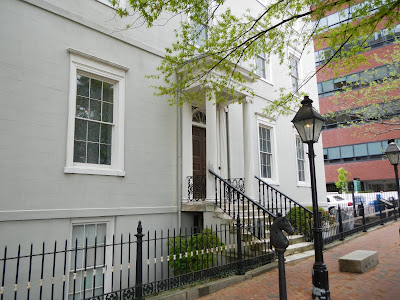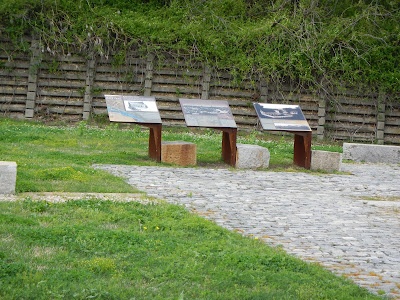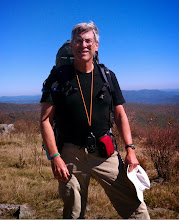You've heard about the newly marked Richmond Liberty Trail, right? What do you say we walk it today, just you and me? Come on!
The Richmond Liberty Trail is not a true trail, but an urban walk along city streets and, for a little bit, canals. It is a 6.2 mile walk according to the official information, but as we will learn later from my very accurate GPS, we'll end up walking nearly 7.5 miles. We'll see lots of Richmond's historic sites and neighborhoods along the way. Part of the Liberty Trail joins the Richmond Slave Trail, which is described here in my walk of about a year ago. Some of my other blog posts that either intersect the Liberty Trail or can be reached from it are these: Black History Walk, the James River, walking to Great Shiplock Park, viewing the great blue heron rookery, hiking around Belle Island, Give me Liberty or Give me a Hike, historic Tredegar Iron Works, and hiking the Buttermilk Springs Trail. So you can see that there are a lot of nice walks in Virginia's capital city that are in or connect to the downtown.
You won't need hiking boots, just a good pair of shoes for our hike. The weather looks very warm and potentially stormy today, so bring a good hat - we'll need to stay alert. Oh, and pack some water and a lunch. Ready? Let's go!
We park along 5th Street near Tredegar, marked on the map by the purple arrow in the lower left of the photo, and start heading up the steep hill, walking the route more or less in a clockwise. It's already very windy, and you laugh as my hat nearly blows off!
Within feet, we come to a freshly painted "trail marker" on the sidewalk. These will be spaced every 100 feet or so and will guide us for the entire route.
At 5th and Franklin, I suggest a quick visit to Liverpool by popping in to the always-welcoming Penny Lane Pub. Surely we have some time for Shepperd's pie and a cold Newcastle brown ale. You remind me that we only just started our walk, and that we have lunch packed. Ah, another time!
Shortly, we pass by the historic Kent-Valentine house. They obviously lived in grandeur in their times. Then we make our way towards Jackson - Ward, a historically African-American part of the city.
There, we go by the Black History Museum of Virginia. We both wish there was time for a visit, but the "trail" beckons.
Along the way, we will see many historical and informative markers, such as this one about Quality Row, a section of Jackson Ward where more affluent blacks lived.
As we leave downtown, we pass by the historic Carpenter Theater, now part of Richmond Center Stage, and main home to the Richmond Symphony Orchestra and a performing arts venue for many other groups. Hey, The Virginia Opera will be performing "The Marriage of Figaro" by Wolfgang Mozart next weekend. Wanna go? You remind me that opera is not your cup of tea, although you have never really seen one. I suggest trying this one - if you end up not liking this masterpiece, you probably won't like any opera. But chances are you will like it. To me, it is 3 hours of musical heaven, and very, very funny to boot. I was once convinced that I didn't like opera, until I found that I do like much of it.
Along Marshall Street, we pass the home of John Marshall, the fourth chief justice of the US Supreme Court. We must take the tour sometime!
As we approach the Court End section of Richmond, bustling with actively from VCU's huge medical center, we decide to take a break on a quiet bench to drink some water and eat lunch - peanut butter and orange marmalade for me, Swiss cheese and baked ham for you. "Pardonnez -moi, monsieur, mais avez-vous un poupon gris?" you ask with a smile. "C'est dommage, mais non. I don't usually carry Grey Poupon mustard on a hike," I reply. We finish lunch and walk by the White House of the Confederacy, now a museum that is furnished as when Jefferson Davis lived there.
Just a few feet away is the Museum of the Confederacy, which is excellent. Whether you think the Confederacy was a great or a terrible idea, this fine museum is worth a visit. Outside, an anchor from the CSS Virginia is on display. Good luck lifting it!
A young woman sits on the curb, face down in her hands, clearly weeping. Given the hospital right there, I imagine she just got some bad news about a loved one. We feel badly for her.
We head along the route towards the State Capital. The first thing we see there is the wonderful Virginia Civil Rights Monument, which commemorates the end of "separate but equal" and full civil rights for all, regardless of race.
Patrick Henry may have said "Give me liberty, or give me death," but it was George Washington who risked death to make liberty happen.
We marvel at the lovely spring colors,
As we pass by the capital building - designed by none other than Thomas Jefferson - and the historic bell tower.
I am two blocks from the office at this point, but not even remotely tempted to go there on my day off, so we keep walking. At Franklin and 15th, we come to the Reconciliation Memorial. There are identical statues in Liverpool and Benin, which were legs in the evil triangle of the slave trade.
We make a little detour to see the site of the infamous Lumpkin's Slave Jail, a holding area and torture center for escaped and uncooperative slaves, and a "holding pen" for slaves being sold down the river. The horrors of this place, once known as "The Devil's Half-Acre" among Richmond's black population, are now long gone. A old African burial ground is very near by.
The oldest house in Richmond is now a museum to Edgar Allan Poe, although I don't believe Poe actually lived in this house.
This building occupies the former site of the Van Lew mansion. Elizabeth Van Lew was a dedicated abolitionist who operated a spy ring for the Union during the Civil War. She was reviled by her neighbors at the end of the war.
We are stirred by the sight of St. John's Church, where Patrick Henry gave his stirring "Give me liberty or give me death!" speech on March 23, 1775. The church is in a neighborhood of restored row homes.
As we head back near the river, we are moved by the sight of the Virginia Holocaust Museum. Something like 10,000,000 souls perished in the Holocaust, driven by one evil madman. The box car sitting out front (to the right in the photo) is representative of those that men, women, and children were crammed into to take them to the death camps operated all over Eastern Europe.
On to more peaceful thoughts, we walk along the canal as we head back to Brown's Island,
where "The Headman" plies his craft in front of cherry trees.
We cross over the bridge and glance at Tredegar Iron Works, now Richmond's Civil War center. We are just a tenth of a mile or so from the car.
I'm really glad that you came along on our walk of Richmond's Liberty Trail. I know that I enjoyed it very much, and hope that you did as well.
Top 12 Moments in My Racing for a Cure Memories
11 years ago
























































